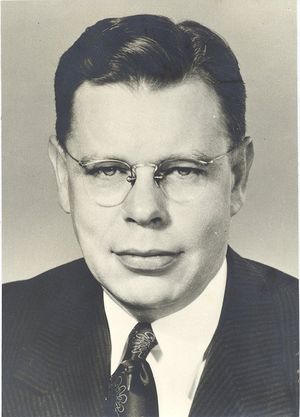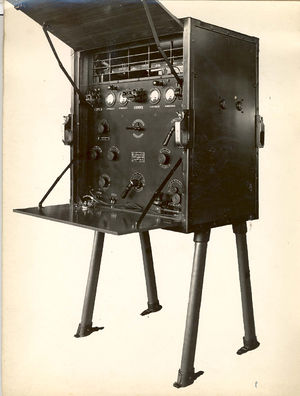James McRae: Difference between revisions
mNo edit summary |
No edit summary |
||
| (One intermediate revision by one other user not shown) | |||
| Line 1: | Line 1: | ||
== | == Biography == | ||
<p>[[Image:2083 - mcrae.jpg|thumb| | <p>[[Image:2083 - mcrae.jpg|thumb|right]] </p> | ||
<p>'''Would you like to help us? Use the edit tab to contribute to this article.''' </p> | <p>'''Would you like to help us? Use the edit tab to contribute to this article.''' </p> | ||
| Line 13: | Line 13: | ||
<p>J. W. McRae was born on October 25, 1910, in Vancouver, British Columbia. He received the B.S. degree in electrical engineering from the University of British Columbia in 1933, and the M.S. and Ph.D. degrees from the California Institute of Technology in 1934 and 1937. </p> | <p>J. W. McRae was born on October 25, 1910, in Vancouver, British Columbia. He received the B.S. degree in electrical engineering from the University of British Columbia in 1933, and the M.S. and Ph.D. degrees from the California Institute of Technology in 1934 and 1937. </p> | ||
<p>Dr. McRae joined the Bell Telephone Laboratories, Inc., in 1937, where he engaged in research on transoceanic radio transmitters and later worked on a microwave oscillator for National Defense Research Council. </p> | <p>Dr. McRae joined the [[Bell Labs|Bell Telephone Laboratories, Inc.]], in 1937, where he engaged in research on transoceanic radio transmitters and later worked on a microwave oscillator for National Defense Research Council. </p> | ||
<p>[[Image:4520-radio transmitter.jpg|thumb|right|Radio transmitter, SC Type BC-127, US Marine Signal Corps, Cardwell Condenser Corporation, May 1930]] </p> | |||
<p>During World War II, Dr. McRae was commissioned a major in the United States Signal Corps, assigned to the Office of the Chief Signal Officer in. Washington, D. C. After working on development programs for airborne radar equipment and radar countermeasures devices, he transferred to the Signal Corps Engineering Laboratories at Bradley Beach, N. J., as chief of the engineering staff. There, he became deputy director of the division and attained the rank of colonel, before returning to civilian life and the Bell Telephone Laboratories in 1945. </p> | <p>During World War II, Dr. McRae was commissioned a major in the United States Signal Corps, assigned to the Office of the Chief Signal Officer in. Washington, D. C. After working on development programs for airborne radar equipment and radar countermeasures devices, he transferred to the Signal Corps Engineering Laboratories at Bradley Beach, N. J., as chief of the engineering staff. There, he became deputy director of the division and attained the rank of colonel, before returning to civilian life and the Bell Telephone Laboratories in 1945. </p> | ||
| Line 23: | Line 25: | ||
<p>Dr. McRae holds membership in the American Institute of Electrical Engineers and Sigma Xi. He has received the United States Legion of Merit and the Eta Kappa Nu Honorary Mention for Outstanding Young Electrical Engineers. </p> | <p>Dr. McRae holds membership in the American Institute of Electrical Engineers and Sigma Xi. He has received the United States Legion of Merit and the Eta Kappa Nu Honorary Mention for Outstanding Young Electrical Engineers. </p> | ||
[[Category:People and organizations|McRae]] [[Category:Engineers|McRae]] | |||
Revision as of 21:40, 30 January 2012
Biography
Would you like to help us? Use the edit tab to contribute to this article.
Born: 25 October 1910
Died:
J. W. McRae was born on October 25, 1910, in Vancouver, British Columbia. He received the B.S. degree in electrical engineering from the University of British Columbia in 1933, and the M.S. and Ph.D. degrees from the California Institute of Technology in 1934 and 1937.
Dr. McRae joined the Bell Telephone Laboratories, Inc., in 1937, where he engaged in research on transoceanic radio transmitters and later worked on a microwave oscillator for National Defense Research Council.
During World War II, Dr. McRae was commissioned a major in the United States Signal Corps, assigned to the Office of the Chief Signal Officer in. Washington, D. C. After working on development programs for airborne radar equipment and radar countermeasures devices, he transferred to the Signal Corps Engineering Laboratories at Bradley Beach, N. J., as chief of the engineering staff. There, he became deputy director of the division and attained the rank of colonel, before returning to civilian life and the Bell Telephone Laboratories in 1945.
In 1946, Dr. McRae was appointed director of radio projects and television research at Bell, with additional responsibility for electron dynamics research, and in 1947, he became director of electronics and television research. In 1949, he was appointed director of apparatus development I, and then director of transmission development. Dr. McRae became vice president in charge of systems development organization in 1951.
Dr. McRae joined the Institute of Radio Engineers in 1931, as an Associate and became an IRE Fellow in 1947. In addition to serving on various IRE Committees, he has been the Chairman of the New York IRE Section, has been a member of the IRE Board of Directors, and he has served on the IRE Board of Editors since 1946. McRae was IRE president in 1953.
Dr. McRae holds membership in the American Institute of Electrical Engineers and Sigma Xi. He has received the United States Legion of Merit and the Eta Kappa Nu Honorary Mention for Outstanding Young Electrical Engineers.

